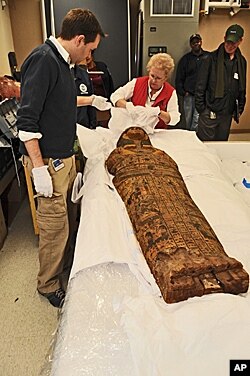In 2008, an ancient Egyptian coffin in a shipping crate raised the suspicions of a customs agent at the Miami, Florida, airport. For the past two years, the ornate sarcophagus has been at the heart of an international mystery and investigation. The ancient artifact was returned to Egyptian possession Wednesday.
The painted wooden coffin, in the shape of an Egyptian man in a state of repose, took center stage at the National Geographic Society Wednesday, quite literally.
The empty 3,000-year-old sarcophagus was at the center of a transfer ceremony as U.S. officials handed over the apparently smuggled artifact to Egypt's chief of antiquities.
John Morton is the Assistant Secretary of Homeland Security for U.S. Immigration and Customs Enforcement, or ICE. His agency is tasked with seizing and investigating illegally imported art and antiquities.
"The case of this particular sarcophagus sounds like an international tale of intrigue that is worthy of a novel. It involved the sale by a Spanish art gallery of a large wooden sarcophagus that was allegedly found in Europe or Egypt - the particular finder was never quite sure - some time around 1970," he said.
But the latest chapter of this 3,000 year-old-tale begins with a customs agent's inkling in 2008 at the Miami airport.
U.S. Customs and Border Protection Agricultural Specialist Herbert Kercado was checking the crate for the usual concerns, such as beetles that can bore holes in wood. But what caught his eye was the documents -- or the lack of documents -- that he felt should accompany a crate carrying a sarcophagus. "How come a sarcophagus was down and through Miami without any documents from the Egyptian government allowing that shipment to come in all the way to Miami?," he said.
He informed Immigration and Customs Enforcement, and Morton said one of its special agents launched an international investigation. "That led us to Spain, Italy, to Egypt. That involved Egyptologists, that involved Interpol, that involved the Egyptian government both here in the US and in Cairo," he said.
The investigation into the shadowy world of antiquities smuggling raised as many questions as it answered. "We learned that the alleged provenance on this particular sarcophagus was not real. The alleged collection from which it came did not exist. The Egyptians had never authorized the export of this particular sarcophagus whenever in fact it was exported, and who knows when that truly was," he said.
Morton said the records of acquisition in Europe either did not exist, or were questionable, so the U.S. government seized the coffin. U.S. officials then demonstrated in federal court that neither the shipper nor the U.S. buyer had legal claim to the ancient artifact, and the coffin was forfeited to the United States.
Secretary General of the Egyptian Supreme Council of Antiquities Zahi Hawass praised the United States for its efforts. "I say this everywhere -- the country that helped us a lot until now in the return of stolen artifacts is the United States," he said.
Hawass said Egyptian and U.S. officials had been in almost daily contact in a bid to return the sarcophagus to its rightful owners -- and to unravel the mystery of just who used to be inside this coffin adorned with colorful painted figures. "He seems to be an important man. Why? The coffin is beautiful. Beautifully decorated, has beautiful scenes. There is no one who is not important who could make a coffin like this," he said.
Hawass, a famed archaeologist and Egyptologist, said the man's name is Imhesy. He said the coffin dates to back to the 21st Dynasty, right after the end of the New Kingdom and the golden age of Egypt. "People can think that the best moment in the life of an archaeologist is actually to discover something, but for me, the best thing is to return something to Egypt," Hawass said.
Hawass has spearheaded efforts to reclaim smuggled and stolen goods, and he has overseen the return of some 31,000 objects to Egypt since 2002.
As for this coffin, it will go on display in Cairo April 7. Hawass says it will ultimately be exhibited at a museum that is under construction in the Red Sea resort town of Sharm el-Sheikh.











